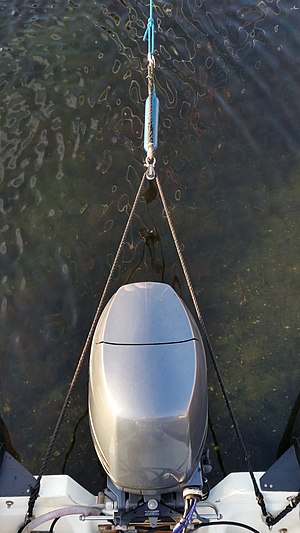Cockpit
In shipping , especially when sailing , a cockpit (English bridle or crow foot ) is a component for distributing and redirecting a force or load .
construction
As a rule, a cockpit is constructed in such a way that a block sits freely movable on a line . The force acts on the block, which in turn distributes the force to the line and thus evenly to the two attachment points (points of application ) of the line. Using a block makes sense to ensure that the force is evenly distributed at all times. If the direction from which the force is acting changes, the block shifts on the line so that the force is again evenly distributed at both attachment points of the line.
A cockpit can also be built without a block, e.g. B. with the point of attack on an eye or a thimble .
application
discharge
By using a rooster foot, the force that would otherwise only act on one attachment point is distributed over two or more attachment points. As a result, only half of the total force acts on the two fastening points, so that the fastening points are less stressed and stressed.
If, with a heavy load, the force were only distributed over one fastening point, this would possibly be overstrained and tear out. In this case, a crow's paw is used to relieve the individual attachment point. (Load distribution to relieve a single attachment point).
division
A cockpit is not only used when you want to relieve a single attachment point. A crow's cradle can also be used if it makes sense to have a load attacked at several fastening points or if it is not possible otherwise due to structural circumstances to use only a single fastening point. (Load distribution for distribution over several fastening points).
example
Hahnepot for towing
For example, a cockpit can be attached to a boat (here: rigid inflatable boat , see picture above) in order to pull or tow another boat . Depending on how heavy the boat is to be towed, it makes perfect sense to use the cockpit for relief.
The tow line is usually attached to the center of the tugboat (based on the transverse axis) to make towing as easy as possible. In this case it is not possible to use a single, centrally attached tow line because the outboard motor is already attached in the middle . In this case, the crow's foot is used to be able to divide the attachment points on the port and starboard sides and still pull them in the middle. The block on the line will position itself under load in such a way that the load of the towed boat is evenly distributed over both attachment points on the tugboat. Another advantage is that the screw of the outboard motor largely passes through the bridle free of the linen and there is no great danger of the line that in the propeller caught.
Hahnepot on the backstay of a sailing boat
A cockpit is sometimes used on sailboats with a trimmable backstay . However, the load that a backstay has to hold is rather low compared to other lines on board a ship. With the trimmable backstay, a crowstay is therefore usually not used to relieve the attachment point, but because it makes sense due to structural properties.
The backstay has the task of preventing the mast from tipping forward; a trimmable backstay makes it possible to influence the deflection of the mast. It makes sense to attach the backstay in the center aft so that the mast is pulled back exactly in the middle of the ship. A rooster pod would not be necessary in this case. When the sailboat heels , a force acts on the transverse axis in addition to the force on the longitudinal axis of the boat. In order to distribute this lateral force evenly to the stern, a cockpit is used in the backstay, which has its fastening points aft port and starboard.
See also
Individual evidence
- ↑ Joachim Schult: Segler-Lexikon: With 5500 keywords . 11th, revised and expanded edition. Delius Klasing , Bielefeld 1999, ISBN 3-7688-1041-0 , p. 220, 221 .
